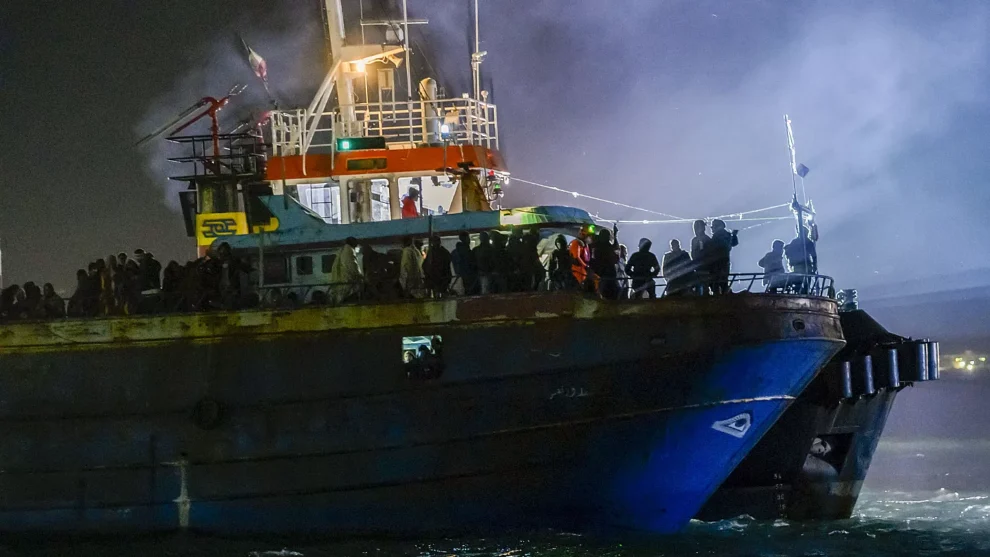Better weather and a crackdown on sub-Saharan migrants in Tunisia might be the reasons why more people are embarking on the perilous journey through the Central Mediterranean.
The number of migrants arriving on Italy’s shores between January and March was more than three times what the country reported during the same period last year, according to a recent report by the UN High Commissioner for Refugees (UNHCR).
According to the UN agency, some 26,800 migrants reached Italy by sea in the first three months of the year, compared to 6,400 in 2022. On Sunday alone, nearly 1,000 people landed on the Sicilian island of Lampedusa, often considered Europe’s gate in the Mediterranean Sea. The day before, 679 migrants arrived on the island — while 23 drowned before reaching its shores.
Lampedusa’s immigration centre, which has the capacity to host about 400 people according to the Italian news agency ANSA, was overwhelmed with more than 1,880 migrants at its facility over the Easter weekend.
It’s not the first time that the tiny Italian island, which at the height of the 2015 Mediterranean migrant crisis saw thousands of arrivals, finds itself stretched for capacity. But the uptick in the number of migrants landing on the island and the overcrowding of its facilities is still a challenge that Lampedusa — and the Italian government — is struggling to handle.
But why are more migrants embarking on the perilous journey through the Central Mediterranean to Italy now?
While it’s hard to find the exact reasons that lead hundreds of individuals to seek a better life in Europe every day, there are some key determining factors that might be contributing to the surge in migrant arrivals to Italy.
Better weather conditions
One crucial factor is the weather, which was likely exploited by smugglers to organise departures from countries like Libya and Tunisia. According to the UNHCR report, some 58% of all sea arrivals to Italy between January and March came from Tunisia; followed by Libya with 38% of arrivals. Last year, 51% of migrant sea crossings departed from Libya; and 31% from Tunisia.
Since the beginning of the year, weather conditions have been ideal for crossing the Mediterranean, with higher-than-expected temperatures and calm winds blowing in the right direction encouraging migrant crossings from North Africa.
Frontex, Europe’s border agency, recognised these ideal weather conditions for migration in a report released in March, which stated that “the Central Mediterranean was the most active route in the first two months of this year with nearly 12,000 irregular border crossings, double the figure from a year ago.”
According to the agency, “in February, the number of detections on this route tripled from a year ago to 7,000.” The number of arrivals in the Central Mediterranean in January and February this year was up 118% from 2022 during the same period. Most migrants arrived from Côte d’Ivoire, Guinea and Pakistan.
An uncertain political situation
While in recent years most of all sea arrivals to Italy came from Libya, the fact that Tunisia has now taken over as the main point of origin for migrant journeys might be a tell-tale sign of the changing political and economic situation in the country.
“In the past Libya was the main country of departure that tells us that there is an influence of what is happening in Tunisia in terms of the economic crisis and the crackdown on sub-Saharan nationals,” UNHCR senior public information associate Federico Fossi told Anadolu earlier this month.
In February, Tunisia’s President Kais Saied attacked the many sub-Saharan nationals in the country, accusing them — without any evidence — of plotting “a criminal plan to change the composition of the demographic landscape in Tunisia” and weaken the country’s Arab Islamic identity.
Talking during a national security council on the subject of migration, Saied claimed that the “hordes of illegal migrants” in the country were responsible for “violence, crime and unacceptable acts” in Tunisia. The tone of the Tunisian president’s attack against sub-Saharan migrants recalls the so-called “great replacement” theory promoted by right-wing extremists in Western countries like the US and France.
There are an estimated 30,000 to 50,000 sub-Saharan migrants in Tunisia, according to NGOs. Many, after arriving in Tunisia with the idea of working there, leave for Europe due to the poor economic situation in the North African country and the mistreatment suffered.
As racist and hate speech against sub-Saharan migrants in Tunisia continues to rise, encouraged by the country’s president, more people are expected to leave the country for Europe’s shores.
Source : Euronews



































